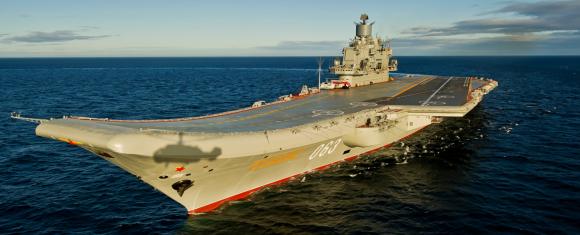 Russia’s only aircraft carrier, Admiral Kuznetsov, has been out of service for years while undergoing maintenance for chronic operational problems. In just the most recent mishap, a fire broke out on the carrier, a few days before Christmas, while undergoing repair work at a shipyard in the Arctic port of Murmansk, according to reports by the Russian state Tass and RIA Novosti news agencies.
Russia’s only aircraft carrier, Admiral Kuznetsov, has been out of service for years while undergoing maintenance for chronic operational problems. In just the most recent mishap, a fire broke out on the carrier, a few days before Christmas, while undergoing repair work at a shipyard in the Arctic port of Murmansk, according to reports by the Russian state Tass and RIA Novosti news agencies.
Admiral Kuznetsov’s ongoing overhaul, which began in 2017 and was initially set to conclude last year, has been beset by failures and accidents. In 2018, the ship was damaged when a crane collapsed as a floating drydock sank beneath the ship. Reportedly, one person died and four were injured in the mishap.
A year later, the carrier suffered what was described as a major fire while being repaired in Murmansk. At least one person died in the fire, while 12 people were injured and two are missing, according to reports by the Russian state news agency TASS.
The fire last month was described by Russian sources as being a “minor fire“. Reports from the Ukrainian media recount more serious problems, describing the carrier as being in such bad shape that it can neither move under its own power nor be towed, for fear the ship might capsize.
The carrier is now reportedly unlikely to return to service until 2024, at the earliest.
Admiral Kuznetsov was ordered in 1981, and commissioned in 1990, but not fully operational until 1995. The carrier has never been deployed for longer than six months and has famously been followed by oceangoing tugboats during all of its sea voyages, in case the ship breaks down.
Recently, Sergey Karginov, a Russian lawmaker who sits on the Duma’s Far East and Arctic committee, has proposed a novel solution: Buy the ex-Soviet aircraft carrier Varyag from China.
The Chinese purchased the unfinished ex-Soviet carrier, Varyag, in 1989. Renamed Liaoning, the ship happens to be a sister vessel to Admiral Kuznetsov, though was never delivered due to the collapse of the Soviet Union. The Liaoning was completed by the Chinese and commissioned in 2012, but may not yet be fully operational.
Liaoning now has an air wing of 40 jets and helicopters. Compounding the strange tale, the Liaoning carries the J-15 fighter, an unlicensed Chinese copy of Russia’s Su-33 carrier jet.
Business Insider reports that China acquired an Su-33 prototype from Ukraine and then reverse-engineered it to develop the J-15. In a bit of poetic justice, China’s copies had a habit of crashing, which Russian media gleefully pointed out.
It seems unlikely that the Chinese would sell the carrier back to Russia. The Liaoning has been the nucleus for China’s emerging carrier fleet. Its navy commissioned a second carrier — the 60,000-ton Shandong, built in China — in 2019. Next was China’s first domestically designed carrier, the Fujian, launched in 2022. The 80,000-ton Fujian is closer in size and capabilities to US Navy nuclear-powered carriers.
The United States has 11 large aircraft carriers with flight decks whose areas are several times greater than all other nation’s navies carriers combined. If you include amphibious assault ships, which would be considered to be aircraft carriers in other navies of the world, the US carrier fleet increases to 20.
Thanks to David Rye for contributing to this post.

One such event, a day off for Healthski and Safetyski on this particular rescue. One cannot help but admire the shiphandling and seamanship of the crew on the back deck, even the rocket launch at 1:24 is a bullseye.
https://www.youtube.com/watch?v=T69Ohs3XvD8
When one considers that a video of a storm often makes it look like a lovely day, the conditions here in the Bay of Biscay must have been horrendous.